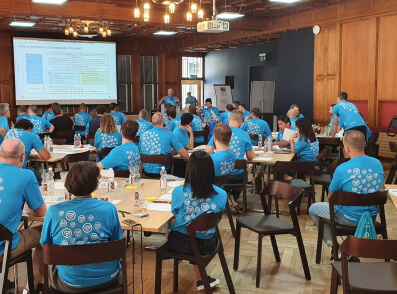This April 28th is World Day for Safety and Health at Work, an international day recognizing the need for safe and healthy working conditions for employees everywhere. It was first conceived by the International Labor Organization (ILO) 18 years ago and has since become a yearly campaign focused on workers’ rights and the need for a healthy work environment.
The recognition of this day feels especially important in the face of the ongoing COVID-19 pandemic, which has caused quite a large shake-up in what the typical workplace looks and feels like now. Many office workers find themselves working remotely, which brings both pros and cons in terms of employee wellness.
Health Issues Employees Face
Health and wellness problems facing the current global workforce have shifted during the past few decades. Corporate Wellness Magazine states that “the main health issues driving wellness strategies globally are physical activity and stress. Nutrition/healthy eating is close behind.”
Of course, physical activity has tremendous “health benefits for hearts, bodies, and minds.” When employees don’t get enough exercise throughout the year, the impact on overall health can be huge over a lifetime. Stress affects the body in so many ways, including negative impacts on appetite, digestive function, memory, and cognitive learning. It’s also no secret that healthy eating is the key to managing weight and lowering the risk of cancer, heart attacks, and strokes.
Focus on Corporate Health
Whether employees are working on-site or from home, many companies are increasingly integrating corporate wellness programs into workplace culture. Gone are the days when a single promotional event highlighting important aspects of overall health and wellbeing for employees was all that a company needed to do to stand out.
Now, initiatives focused on a more holistic approach to employees’ health — both physical and mental — are becoming the norm worldwide. In fact, the global corporate wellness market is expected to grow to nearly USD 99.36 billion by the year 2027.
Corporate Wellness Initiatives
Health issues facing the average employee stack up over time and spill over into work performance and company spending. For example, healthcare costs related to treating major illnesses and diseases are the biggest expenses most businesses face. The idea behind a corporate health initiative is to work on prevention.
This means helping employees make changes in their lives that lead to better health and wellbeing in the long run. A 2017 study found that companies that offered a corporate health program saved $3.27 in healthcare costs for every dollar spent on the program itself. The same study found that the average worker involved in one of these programs increased their productivity by 5%, which translates into one additional day of work every month.
dacadoo’s Digital Health Engagement Platform
Wheel of Life™, dacadoo’s Digital Health Engagement Platform (DHEP), uses a dynamic interface that encourages employees to set health goals and follow through on them. It offers up to 120 different activities for users to choose from and even includes the dacadoo Health Score, so users always know where they stand when it comes to their health. With the capabilities for mass user on-boarding and unique customization, Wheel of Life™ captures the ethos of the #WECARE movement.
Why #WECARE Is Crucial
In 2021, and in the future, offering a corporate wellness program like Wheel of Life™ will be the key to employee recruitment and retention worldwide. Companies that offer these programs see a large increase in employee loyalty.
When the goal is to attract the best talent out there and keep them, the best way to do so is to increasingly show a strong sense of caring for employee health and wellness. dacadoo’s #WECARE strategy places the focus back on prevention by encouraging healthy lifestyle changes to show your employees you really care.
Request a complimentary Wheel of Life™ demo.

















